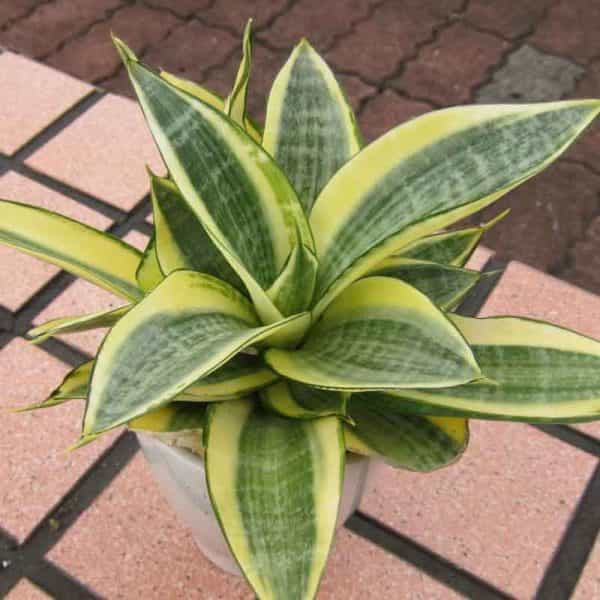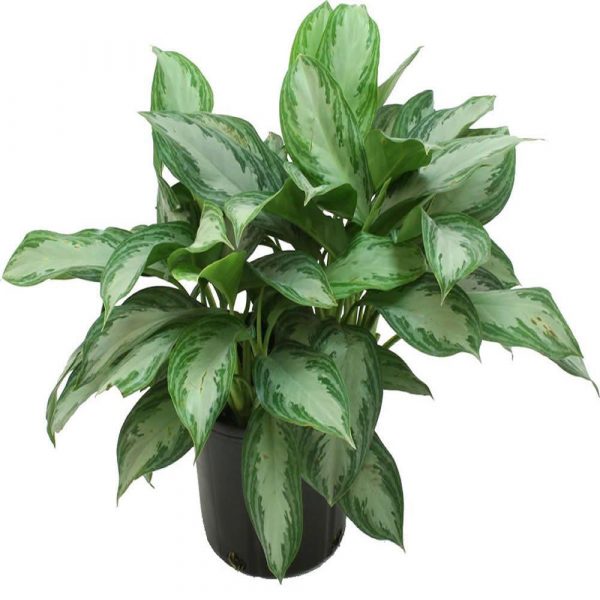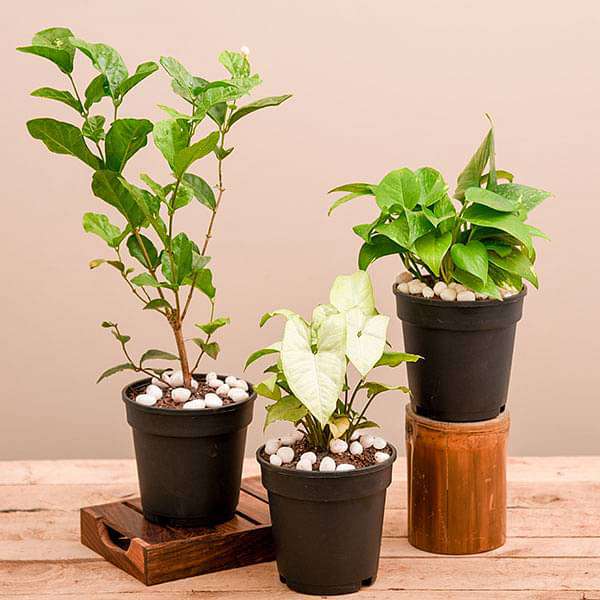Dracaena trifasciata, commonly known as the snake plant, is one of the most popular and hardy species of houseplants. Up until 2017, it was botanically classified as Sansevieria trifasciata, but its commonalities with Dracaena species were too many to overlook. The plant features stiff, sword-like leaves and can range anywhere from six inches to eight feet tall. Snake plants can vary in color although many have green-banded leaves and commonly feature a yellow border. These plants are easy to grow and, in many cases, are nearly indestructible. They will thrive in very bright light or almost dark corners of the house. Snake plants generally grow slowly in indoor light, but increasing its exposure to light will boost growth if it receives a few hours of direct sun. Planting and repotting is best done in the spring.
WARNING
This plant is toxic to cats and dogs.1
| Common Name | Snake plant, viper’s bowstring hemp, St. George’s sword | |
| Botanical Name | Dracaena trifasciata (formerly Sansevieria trifasciata) | |
| Family | Asparagaceae | |
| Plant Type | Evergreen, perennial | |
| Mature Size | Six inches to 8 feet tall | |
| Sun Exposure | Shade to partial sun | |
| Soil Type | Sandy, well-drained | |
| Soil pH | Slightly acidic to slightly alkaline | |
| Bloom Time | Spring (blooms are rare) | |
| Flower Color | White | |
| Hardiness Zones | 9–11 (USDA) | |
| Native Area | West Africa (tropical) | |
| Toxicity | Toxic to cats and dogs |
Snake Plant Care
Snake plant is an ideal choice for beginner gardeners because it is difficult to kill. It’s great in a container and grows well on the floor or on tabletop displays. Snake plant thrives in warm weather and struggles in cold conditions. This plant is drought-resistant but is susceptible to overwatering which lead to root rot.2 Only water the plant if the soil feels dry. These plants can go two months between waterings in the winter months. In warmer months, water no more than every two weeks.
Light
Snake plants prefer indirect but steady light with some direct sun. They can adapt to full sun conditions and will also survive dimly lit situations.
Soil
Snake plants prefer a loose, well-drained potting mix. This plant will do well in sandier soils. Use a potting media low in peat content. Peat works well in many situations, but it can become tightly packed and sometimes has problems rehydrating or draining. An all-purpose cactus potting soil is a good choice.
Water
Let the soil dry between waterings. During the winter, reduce watering to monthly, or whenever the soil is dry to the touch. Err on the side of under-watering; too much water can harm the plant.
Temperature and Humidity
Snake plants prefer warm conditions and will suffer if exposed to temperatures below 50 degrees Fahrenheit. Set the plant in a place where it will be protected from drafts. A temperature range between 70 and 90 degrees Fahrenheit is best. Frost will kill this plant.
Fertilizer
Feed with a mild cactus fertilizer during the growing season or a balanced liquid slow-release 10-10-10 fertilizer or a 20-20-20 fertilizer diluted to half strength. Do not fertilize in the winter.
Types of Snake Plant
- Dracaena trifasciata ‘Hahnii’: It is also called bird’s nest snake plant, it grows to only about six inches tall. Its leaf clusters form a bird’s nest clump.
- Dracaena angolensi (formerly Sansevieria cylindrical): This cylindrical snake plant has round, stiff leaves that can reach several feet in length. The leaves arch outward from a central crown.
- Dracaena trifasciata ‘Laurentii’: This variegated snake plant has creamy yellow leaf margins. To propagate this plant, it must be divided rather than propagated from leaf cuttings.
- Dracaena trifasciata ‘Twisted Sister’: This plant has twisted leaves striped horizontally with yellow variegated edges. It grows about 15 inches tall.
- Dracaena trifasciata ‘Bantel’s Sensation’: This snake plant grows about three feet tall and has narrow leaves with white vertical stripes.
- Dracaena pearsonii: Sometimes called rhino grass, this plant grows about 12 inches tall with succulent red-tinted leaves.
Propagating Snake Plant
It’s best to propagate during the growing season in the spring or summer. Dracaena plants can be divided easily during repotting if the plant is at least four inches tall. Alternatively, new shoots might emerge from the soil and can be potted independently. You can also propagate snake plants via cuttings. Follow these instructions for both methods.
Propagate via root division:
- Gather a sharp knife, a clean pot, and cactus potting soil.
- Pull the root ball out of the old pot and place the plant on a flat surface. Using your hand, gently brush away the soil from the root structure or rhizome.
- Using the sharp knife, divide the plant into sections, making sure the roots for each section remain intact. Cutting through the plant will not kill the plant.
- Replant the new snake plant sections into a clean pot with cactus potting soil.
- Water it and place it in a partly sunny location.
Propagate new offshoots:
- If you notice any new pups or baby offshoots that the plant has developed, you can plant those separately.
- As with root division, you’ll need a sharp knife, a clean pot, and cactus potting soil.
- Pull the root ball out of the pot, locate the offshoot’s root, cut off the pup and plant the cut root end in the cactus potting soil.
- Water it and place it in a location with indirect bright light.
Leaf-cutting propagation:
- Using sterilized scissors, a sharp knife, or pruning shears, slice off a long, healthy leaf from your snake plant.
- Root the leaf cutting in water by placing it in a clean jar of water, submerging the cut end. Place it in a partially sunny spot and look for root growth.
- Every few days, top off the water, keeping it level. Every two weeks, dump the old water and refill with clean water to inhibit bacterial or algae growth.
- Once roots develop at least an inch long, plant the root end in a well-draining cactus potting mix.
- Water it and place it in a partially sunny spot.
Optionally, you can skip the water rooting method. After cutting a healthy leaf from your plant, allow the cut end to callous over for 24 hours, and then pot it, cut-end down, in the cactus potting mix. It is a slow-growing plant, so it could take two months before you notice new growth.
How to Grow Snake Plant From Seed
Snake plants can be grown from seeds, but it’s easier, quicker, and more reliable to propagate by other methods. Snake plant seeds tend to have low germination rates. It can take between three to six weeks before you see a seedling.
To grow from seed, fill a three-inch pot with a well-draining cactus potting mix or seed starting mix. Sprinkle the seeds on top of the starting mix. Place the pot in a warm, sunny spot. Cover the pot with plastic wrap or a clear plastic dome to retain warmth and humidity. Once you notice seedling growth, remove the plastic covering. Keep the soil lightly moist but not too soggy or wet throughout the germination process. The seedling will be ready to repot when it is three to four inches tall.
Potting and Repotting Snake Plant
When potting, choose a sturdy pot material as strong roots can easily crack and break weak pots. Dracaena is a generally slow grower that rarely needs repotting, but if given ample sunshine, they might grow rapidly and require repotting or dividing. The best time to repot these plants is in the spring. When repotting, always use fresh potting soil, a cactus potting mix, or a mixture of both.
Overwintering
Snake plant is a tropical plant that can die in temperatures consistently lower than 50 degrees Fahrenheit or if affected by a wintery frost. Bring the plant indoors before temperatures drop that low. Keep the snake plant in a warm room, protected from cold drafts, and maintain the soil on the drier side. During the winter, snake plants enter dormancy and will stop growing. In the winter, you will only need to water the plant every six weeks or so.
Common Pests
Snake plants are susceptible to many common houseplant pests such as scales, gnats, spider mites, aphids, mealybugs, and whiteflies.3 You can avoid an insect invasion if you keep your plant healthy. Insects usually attack a plant when it suffers from environmental issues like incorrect water levels, humidity, and air circulation. If you notice insects on your plant, remove the insects by picking them off, by using a gentle spray of water, or with an organic neem oil to keep the insects at bay.
How to Get Snake Plant to Bloom
Snake plants develop creamy-white, tubular flowers that look similar to lilies. It flowers annually when its water, sun, and humidity needs are ideal. However, when these plants are grown indoors year-round, they rarely flower. The change of seasons, namely advent of spring, kickstarts the plant out of dormancy and spurs its growth. Its flowers are fragrant, and like other dracaena species, it blooms at night. There is no need to deadhead these flowers; they drop on their own.
Common Problems With Snake Plant
Snake plants are one of the easiest plants to maintain, multiply, and keep for years, whether you’ve got a green thumb or not. The biggest snake plant health problems center around watering. Overwatering causes plant diseases like fungal infections and root rot.2
Foul-smelling Soil
If you notice that the soil smells like it’s rotting, it likely has root rot.4 Scoop out some of the soil and put it up to your nose. Root rot smells foul. You can try to save the plant, but you need to inspect the roots to determine if you’ve saved the root system in time. Pull the root ball out of the container. Cut away any brown, mushy roots or leaves. Repot a portion of healthy root rhizome in fresh cactus potting mix or a well-draining potting mix. If you can’t save the rhizomes, discard them. Propagate a new snake plant from leaf cuttings.
Yellow or Brown Leaves
Healthy snake plant leaves are green with some silver or yellow streaks. Yellow or brown leaves can indicate several conditions, including overwatering, pests, and root rot. You can remedy each of these conditions if you manage the plant’s water level appropriately. Overwatering causes root rot and stresses out the plant, making it more susceptible to pests.
Curling Leaves
Thrips are a common pest infestation that can cause curling leaves.5 Use a magnifying glass to inspect your plant’s leaves closely. These tiny black bugs are easy to deal with. Cut away severely curled leaves and spray the plant with neem oil or vegetable soap to keep the pests at bay. New leaves will eventually grow.
Leaves Falling Over or Drooping
Healthy snake plant leaves grow upward and stand erect, but too much water, insufficient light, or poor potting material can make the plant’s leaves droop or flop over. If you don’t use a well-draining potting mix, the soil becomes soggy and affects the foliage. Move the plant to a brighter location, reduce the frequency of watering, and change the soil to one that drains better, if necessary.






Reviews
There are no reviews yet.